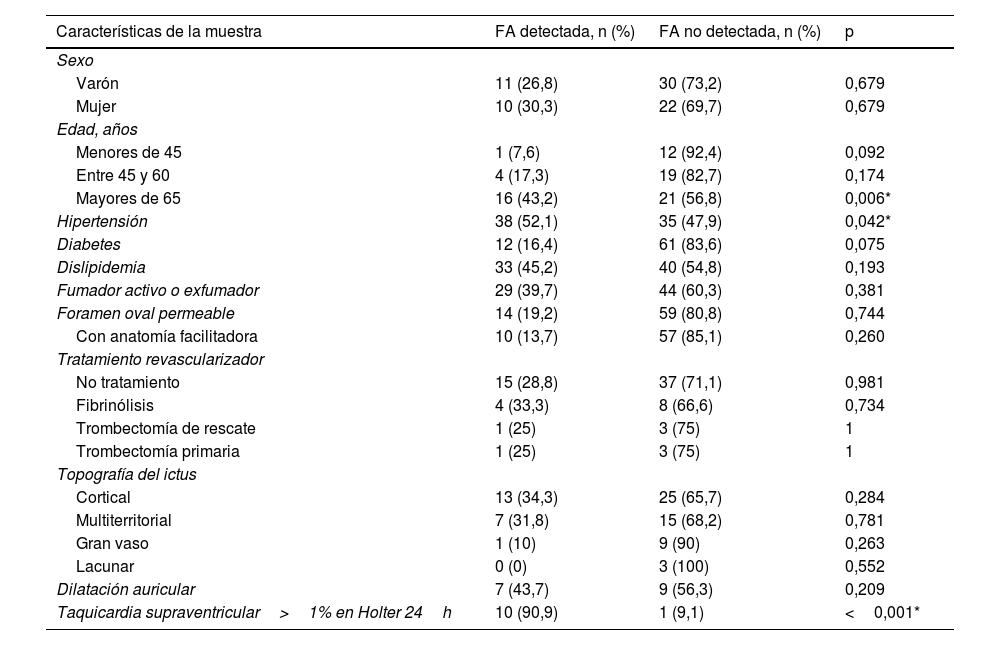El ictus criptogénico constituye el 25% del total de ictus isquémicos, de los cuales un 20-30% son debidos a fibrilación auricular (FA). Con el objetivo de aumentar la tasa de detección, surgen los dispositivos de monitorización prolongada implantables. El estudio del perfil del candidato ideal subsidiario de dicha monitorización otorgaría un mejor entendimiento de los mecanismos que subyacen en este subtipo de ictus.
ObjetivoDeterminar qué variables están relacionadas y pueden predecir la detección de FA silente en pacientes con ictus criptogénico.
Pacientes y métodosSe trata de una cohorte longitudinal con selección desde marzo de 2017 hasta mayo de 2022. Son pacientes portadores de dispositivo de monitorización implantable e ictus criptogénico con monitorización mínima de un año.
ResultadosEl total de pacientes incluidos fue de 73, con edad media de 58,8 años, siendo el 56,2% varones. Se detectó FA en 21 pacientes (28,8%). Los factores de riesgo cardiovascular más frecuentes fueron hipertensión (47,9%) y dislipidemia (45,2%). La topografía más frecuente fue cortical (52%). En cuanto a los parámetros ecocardiográficos, un 22% tenían la aurícula izquierda dilatada, un 19% tenían foramen oval permeable y un 22% presentaron taquicardia supraventricular de alta densidad (>1%) en el Holter. En el análisis multivariante, la única variable predictora de FA es la presencia taquicardia supraventricular de alta densidad, con un área bajo la curva de 0,726 (IC 0,57-0,87, p=0,04), una sensibilidad del 47,6%, una especificidad del 97,5%, un valor predictivo positivo del 90,9%, un valor predictivo negativo del 78,8% y una exactitud del 80,9%.
ConclusionesLa presencia de taquicardia supraventricular de alta densidad puede ser orientativa para predecir FA silente. No se han observado otras variables que nos permitan predecir la detección de FA en estos pacientes.
Cryptogenic stroke constitutes 25% of all ischemic strokes, of which 20–30% are due to atrial fibrillation (AF). With the aim of increasing the detection rate, implantable long-term monitoring devices have emerged. The study of the profile of the ideal candidate subsidiary to such monitoring would provide a better understanding of the mechanisms underlying this subtype of stroke.
ObjectiveTo determine which variables are related and can predict the detection of silent AF in patients with cryptogenic stroke.
Patients and methodsThis is a longitudinal cohort with recruitment from March 2017 to May 2022. They are patients with an implantable monitoring device and cryptogenic stroke with a minimum monitoring of one year.
ResultsThe total number of patients included was 73, with a mean age of 58.8 years, 56.2% were male. AF was detected in 21 patients (28.8%). The most frequent cardiovascular risk factors were hypertension (47.9%) and dyslipidemia (45.2%). The most frequent topography was cortical (52%). Regarding the echocardiographic parameters, 22% had a dilated left atrium, 19% had a patent foramen ovale, and 22% had high-density supraventricular tachycardia (>1%) on Holter monitoring. In the multivariate analysis, the only variable that predicts AF is the presence of high-density supraventricular tachycardia, with an area under the curve of 0.726 (CI 0.57–0.87, p=0.04), sensitivity of 47.6%, specificity of 97.5%, positive predictive value of 90.9%, negative predictive value of 78.8%, and accuracy of 80.9%.
ConclusionsThe presence of high-density supraventricular tachycardia can be indicative for predicting silent AF. No other variables have been observed that allow us to predict detection of AF in these patients.








